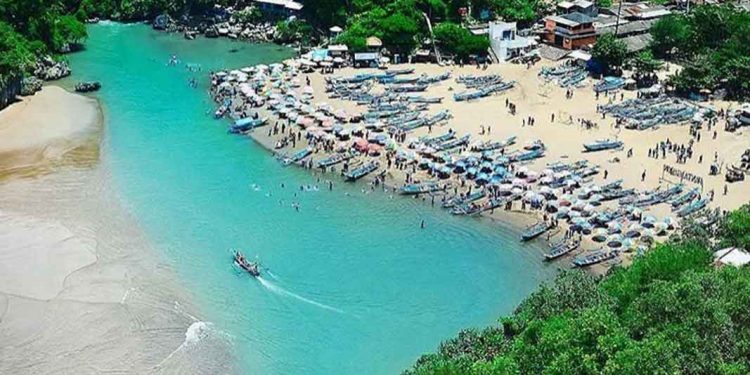A few cloudy clouds can be seen hanging in the sky when walking along the winding road in Gunungkidul. A hot and dry aura accompanies us along the way, providing the perfect backdrop for the craggy hills that characterize the district.
This atmosphere suddenly turned fresh when we passed the entrance gate to the Baron Beach area when rows of dry teak replaced fresh green trees.
After passing the tempting rows of seafood stalls, we arrived at the stunning Baron Beach. This “U” shaped beach is flanked by two rows of rocks on either side, holding back the waves of the southern sea which continue to be raging incessantly.
On the west side, there is a stream of fresh water that appears out of nowhere. The river, which is only a few hundred meters long, empties right on the beach, presenting a unique sight as fresh water and seawater greet each other. Dozens of ships lined up on the brownish-white sand, waiting for the tide to come at night.
Baron…
This name is a little strange because it doesn’t impress Njowo at all, in contrast to the names of neighboring beaches such as Krakal, Kukup, and Indrayanti. Even stranger, the word “baron” actually comes from the lowest title of aristocrats in various medieval European empires.
After tracing, it turns out that the name of this londo beach refers to the ketoprak character Baron Sekeber. Unlike ketoprak figures in general, Baron Sekeber is a Dutch aristocrat (some say Spanish or Portuguese) with high supernatural powers and even fought Panembahan Senopati, the founder of the Mataram Sultanate. Well, in the 1930s this beach was used as a hiding place and weapons storage by the Dutch, but not many local residents lived around it. We also thought, maybe this beach was named Baron Beach because there were many Dutch people who had lived there, then it was linked to the legend of Baron Sekeber. This beach was finally named Baron Beach to commemorate the story of the magic foreigner (AH Farhani, 2008).
Despite this assumption, Baron Beach still presents a view that we cannot miss.
The green color of the underground river water blends perfectly with the greenery above, before finally colliding with the bluish seawater. The sand is not too white, but it is quite beautiful when combined with the two towering coral hills around it. We are discouraged from swimming because the ruthless Indian Ocean waves can drag us into the middle of the ocean.
Don’t worry, we can still enjoy the blue sea from the charter boat to get around the beautiful Baron Beach area.
The lighthouse high above the reef
On top of the cliff to the east, we can see a white tower that rises over the cliff, reminiscent of Minas Tirith from The Lord of The Ring trilogy. Out of curiosity, we approached the tower via a rocky staircase which is just to the east of the beach. After a few hundred meters, we arrived at the Tanjung Baron lighthouse complex which is right at the top of a cliff, just like Minas Tirith above The City of Kings. The difference is, there is no city under this lighthouse, only a vast ocean with its fierce waves.
According to the lighthouse keeper, the white tower was only built in February 2014 and inaugurated in December of the same year. This 40-meter high lighthouse was erected to replace the old lighthouse beside it, in the form of an iron tower that looks very porous. Apart from replacing the old lighthouse, this tower was also built to add to the tourist attractions in the Baron Beach complex.
Its original function as a guide for passing ships has also been maintained, even though most ships already have more sophisticated navigation tools.
Lighthouses serve as distance markers and are separated every 12 nautical miles (about 22 km), all of which are operated by the Director-General of Sea Transportation with the head office in Cilacap. The lights on top of the tower swirled to easily attract the attention of sailors.
The room inside the lighthouse is quite large, consisting of 9 multi-faceted floors. Each floor is connected by a spiral staircase which is quite steep and narrows at the top.
On even floors, there is a balcony that we can use to observe the view around the lighthouse.
On the 7th floor, the spiral staircase is replaced by a slippery vertical staircase, so it is recommended that you remove your footwear when climbing the stairs. After passing through this rather horror staircase, then we can see a spectacular view: a line of karst hills that extend to the north, contrasting with the undulating ocean expanse in the south.
From the top of this tower, the wind blows lightly to reconcile the fatigue that is felt when we climb the steep stairs.
The vast ocean becomes a perfect background for taking pictures with various poses, but we still have to be careful with the strong winds that sometimes blow from the direction of the ocean.
At the top of the lighthouse, there are also some sensitive instruments that we should not touch, such as rotary lights, batteries, and solar panels that supply electric power to the entire lighthouse. In essence, we must be careful and keep this building from being damaged, given its vital function for sailors crossing the Indian Ocean.
In the afternoon, we can enjoy the view of the sunset behind the lighthouse.
Location: Kemadang, Tanjungsari, Gunungkidul, Yogyakarta Region
Entrance ticket :
Rp10,000
IDR 2,000 (motorbike)
IDR 5,000 (car)
IDR 20,000 (bus)
Baron Beach Opening Hours: Monday – Sunday: open 24 hours



